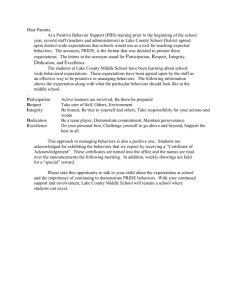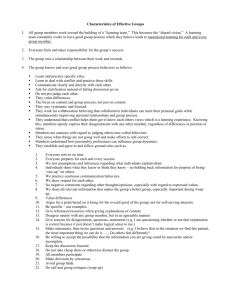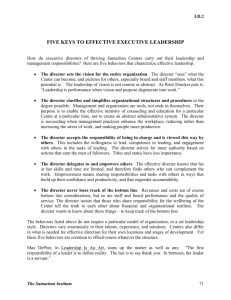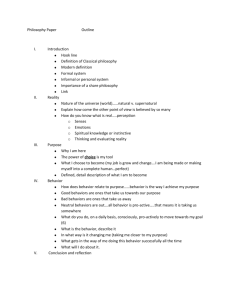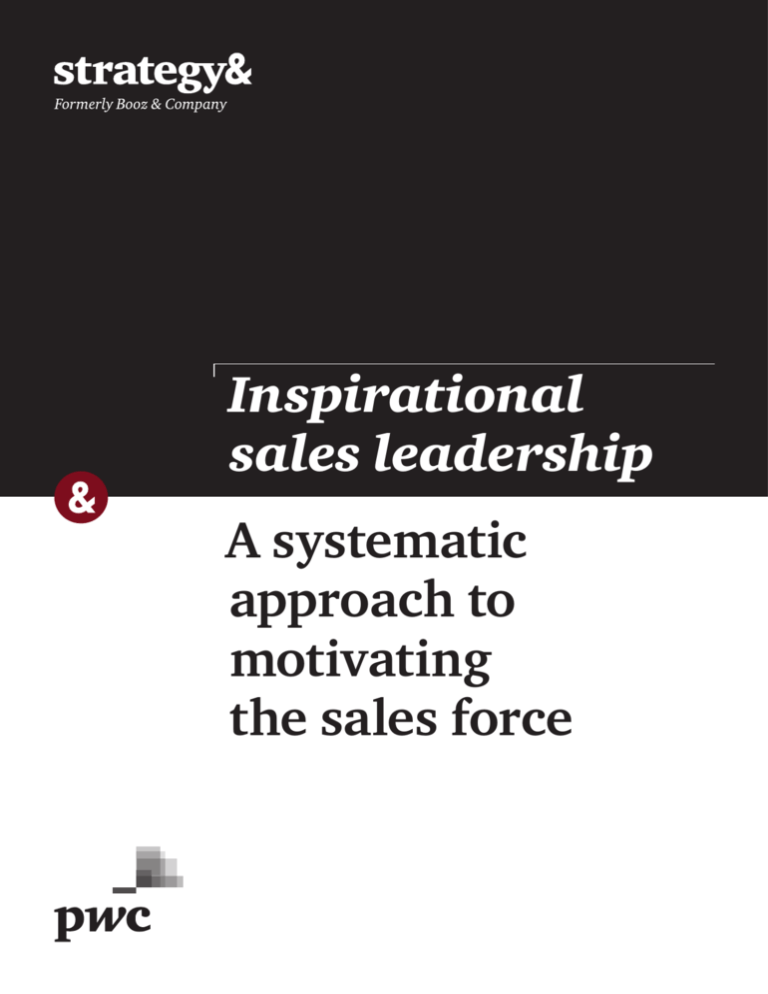
Inspirational
sales leadership
A systematic
approach to
motivating
the sales force
Contacts
New York
Tracy Entel
Partner
+1-212-551-6093
traci.entel
@strategyand.pwc.com
Jon Katzenbach
Senior Executive Advisor
+1-212-551-6115
jon.katzenbach
@strategyand.pwc.com
This report was originally published by Booz & Company in 2010.
2
Strategy&
Executive summary
Today’s complex business-to-business sales environments call for a
different sales leadership approach than the tried-and-true methods
that worked when selling was more transactional. The drivers of
success in a complex selling environment — such as investment in
strategic relationships and insights, tolerance for risk, high-quality
teaming, relentless focus on differentiation — require a new approach
to sales leadership. “Inspirational sales leadership” leverages a deep
understanding of current sales performance to systematically identify
leadership behaviors that actually drive results, and then provides
the right tools for change. This leadership approach is every bit as
disciplined as more traditional approaches, and extends focus and
discipline to performance drivers that too many sales organizations
leave to chance and individual temperament. Strategy&’s research and
practice has demonstrated that this model works effectively across a
broad range of B2B contexts, and will become increasingly critical to
master as the complexity and value of strategic selling continue to
increase.
Strategy&
3
A new approach to
sales leadership
Sales productivity is one of the most studied areas of business. Much
has been written on how sales leaders can drive value through triedand-true methods such as clearly articulated targets, a thoughtful use
of variable compensation and incentive rewards, transparent metrics,
a focus on the individual, and robust support systems. These classic,
formal sales management tactics work supremely well for simple,
transactional sales: when individual deals are small, they’re closed
in large numbers, and the product or service offerings are relatively
contained and independent.
The sales leadership questions that are most critical to driving value
in today’s business-to-business sales environment, however, are
generally more complex and require a deep understanding not only
of the company’s products and services offerings, but also of how the
customer’s own business functions and creates value. Deals that bring
to bear the best of the enterprise to a complex customer need require
the salesperson to tie together many internal as well as external
capabilities. They typically have a long time horizon, and have a
high potential value and a corresponding high level of risk. Outcomes
on these types of very large deals are much less predictable, and
significantly affect overall company results. Successfully reading the
signals of when a large, complex deal is moving forward or getting
stalled requires a sophisticated understanding that can’t be captured
in pipeline tracking systems. The sales leader needs to be in intense
dialogue with his or her sales representatives to help recognize these
signals, motivate the right responses, and move the process along at
different stages of the sales cycle.
In an environment of many different ways to sell, how do leaders focus
their sales force sufficiently on these more uncertain, less controllable,
but an order-of-magnitude higher-value opportunities? And how do they
do this without sacrificing predictable quarterly results? How do they
manage the tension between needing a steady flow of top-line results
and capturing the greater long-term growth offered by pursuing the
most complex deals? And finally, how do the best leaders use nonmonetary motivation to keep the individual sales representatives
4
Strategy&
excited and inspired during complex sales cycles that don’t move fast
enough to provide motivation solely from results and commissions, and
that don’t provide easy-to-interpret “proof points” of success very often?
By marrying critical formal and classic elements of sales strategy
with “informal” and “inspirational” sales leadership, Strategy& has
developed a new approach to sales excellence. “Inspirational sales
leadership” helps our clients get the most from their people by
identifying the leadership behaviors that motivate the right mix
of results, and then systematically applying those behaviors to help
their teams reach new levels. Inspirational sales leaders are able to
create a sense of purpose, pride, and commitment, which translates
into improved performance across every part of a sales team (see
Exhibit 1, next page).
Strategy&
5
Exhibit 1
The difference between “good” and “inspirational” sales leadership
A “good” sales leader will …
Targets
– Set clear “stretch” but realistic performance targets
An “inspirational” sales leader will …
– Consistently coach representatives on finding the balance
between number of deals in the pipeline, and depth of
relationship per deal
– Occasionally set “impossible” goals to inspire quantum
leap improvements
Metrics
– Provide rationale for the metrics imposed from “above”
and help representatives accomplish them
– Manage the scorecard to drive as many “greens”
as possible
Supports
– Coach representatives and teams using a
comprehensive model for sales performance;
coach low performers to improve their results
– Use the same consistent motivational approach with
everyone on the team to ensure fairness
Teaming
– Encourage teaming, and include shared/team
incentives in the mix
– Create meetings and formal processes to enhance
cross-functional collaboration
Rewards
– Select and focus on a few metrics most relevant to the
business unit's current strategy and connect them to
individual definitions of success in a way that drives the
other metrics up as well
– Coach a few, specific behaviors that are directly connected
to performance drivers—know the “DNA” of your sales force
– Spend time to create high-impact opportunities for high
performers, and build skills with middle performers; pay
minimal attention to or counsel out low performers
– Consciously and consistently build the right informal
networks inside and outside the company to enhance
collaboration within the team, across functions and
business units, and with clients and suppliers
– Step in to help hands-on with high-impact deals
– Coach representatives/teams to close high-impact deals,
rather than coming in to close them yourself
– Reward top performers—e.g., “100% club”—and help
middle performers anticipate and strive for success
– Leverage client recognition (being a valued thought partner
to the client) as the main source of motivation
– Recognize not just results (lagging indicators), but
also effort and skill (leading indicators)
– Recognize and reward the emotional side as well—e.g., the
courage to have the right dialogues; willingness and ability
to bring together the right people/strengths to go after
distinctive, high-value opportunities; willingness to take risk
Source: Strategy&
6
Strategy&
A flexible approach to change
For companies adept at putting in place the formal structures and
processes they need to operate, harnessing the power of the “informal”
can be a very powerful addition. While each company’s approach will
be different, the best change programs leverage a deep understanding
of current sales force performance to systematically identify the
leadership behaviors that actually drive results, and then provide
the right tools for change.
A. Understand the opportunity
Achieving inspirational sales leadership starts with an understanding
of how individual and team actions influence the top line as well as the
bottom line. A detailed map of sales representative performance will
highlight specific disciplines and behaviors that make a difference for
that particular company’s sales success. We help our clients develop a
company-specific performance equation that provides leaders with a
detailed breakdown of the behaviors that actually drive differences in
sales performance, and then estimate the potential impact of change.
Creating a performance equation and identifying winning behaviors is
relatively straightforward for the simple, transactional sale; bringing
the same level of rigor and discipline to identifying and driving effective
sales behaviors in large, complex, long-term deals is less common and
more difficult, but has high payoff compared to steering on intuition
(see Exhibit 2, next page).
B. Catalog the specific individual and leadership behaviors
that drive sales performance
Inspirational sales leadership requires an understanding of the
“right” (value creating) behaviors of salespeople as well as sales leaders.
By identifying and studying exemplary managers and their teams,
organizations can begin to build a blueprint of the leadership actions
that salespeople individually and departments collectively find to be
inspirational.
Strategy&
7
Exhibit 2
Performance equation: A professional services example
New clients
Active
prospects
Determine the
components of
value creation
Total
prospects
Identify drivers
of productivity
Networking
Issue
identification
– Managing
relationships
– Identifying
needs
– Asking for
referrals
– Building
trusted
relationships
Prioritize
1 or 2 specific
behaviors for
coaching
x
Total
prospects
Existing clients
x
Client
conversion
rate
x
Solution
development
Average
profitability
Client
x
Average
length of
client
relationships
Pricing and
product mix
Client
satisfaction
– Understanding
internal decision
making
– Developing
ROI business
cases
– Ensuring
smooth
implementation
– Differentiating
solutions
– Negotiating
based on value
– Responding
quickly to
problems
Source: Strategy&
8
Strategy&
Instilling pride in others is an underutilized, but learnable, leadership
capability. Different companies’ corporate cultures, sales environments,
and even individual leaders’ personalities dictate how to motivate
employees. However, the most powerful sales leaders everywhere
tend to focus on a select few actions that drive performance:
• Effectively translating senior leadership messages and decisions. The
best sales leaders are typically described as a “buffer,” clarifying
local constraints and circumstances upward to leadership while
effectively translating company objectives and goals into a
compelling vision for their teams. They apply an effective filter
and translation, rather than just “passing along the message.”
They don’t just explain corporate metrics, but adapt and select what
they find drives performance against particular goals for each team
member, thus creating more motivation and avoiding “gaming the
system.” Finally, they ruthlessly prioritize among different requests
and opportunities to keep their sales forces focused on the mix of
activities that will most reliably lead to both short-term results and
long-term growth. In short, they play a true leadership role, rather
than just a management role “in the middle.”
• Adapting leadership and coaching to individual sales representatives’
styles, needs, and preferences. Inspirational sales leaders are well
aware that different individuals have different motivations and
needs, and they vary their own style accordingly. An especially
effective leader we have worked with consciously assesses each
sales representative’s “ideal level of energy,” and creates productive
“stretch” for each person according to the level of tension at
which each performs at his or her personal best. He inspires some
representatives mostly through positive reinforcement — “you can
do it, you’re the best” — and others mostly through constructive
criticism, each according to their individual profile and preference.
In complex sales
situations, the
best sales leaders
find ways to
build pride in
the behaviors
that have the
highest longterm impact
for both the
individual
and the
organization.
• Focusing on team behaviors that lead to business results. In complex
sales situations, the best sales leaders find ways to build pride in
the behaviors that have the highest long-term impact for both
the individual and the organization. For example, while incentive
compensation will build pride as a token of recognition for
achievement of short-term results, more sustainable and valuable
motivation for a salesperson can be derived from becoming a
valued long-term thought partner to the customers. Outstanding
sales leaders coach their representatives on the behaviors that will
earn their customers’ trust and appreciation, and relentlessly point
out to them the importance and value of that trust, both to the
company and to the representative. Another example: In situations
where teaming is required, stimulating pride in the extended sales
team and its performance may lead to better collective results than
Strategy&
9
focusing on the pride derived from outperforming peers — even
though salespeople often thrive on competition. The most successful
sales team leaders identify these sources of motivation and find
ways to encourage, recognize, and celebrate the related behaviors.
• Creating different ways of “winning.” Because winning is important
to most sales professionals, but not always possible (especially
when the ideal mix contains longer-term, more complex deals), the
best sales leaders are creative in finding ways for their teams to
experience tangible success. Inspirational sales leaders may consider
intermediate milestones, collaboration awards, and client impact
recognition in addition to simple revenue targets. These milestones
need to be based on proven predictors of business results, such as
generating a specifically desired type of customer prospect dialogue,
and cannot be attained merely by “showing up,” if they are to have
true motivational impact.
• Building collaboration across functional groups. Exemplary sales
leaders behave as “hubs” in informal networks of specialist,
functional, and other resources. They drive pride in collaborating
to bring all perspectives to bear on a customer’s need. They are
very deliberate about the networks they build (and encourage their
sales teams to build), and value quality over quantity. For example,
they seek out knowledge from people and groups with different
perspectives. Rather than staying within a more comfortable and
familiar range of experts similar to themselves, they reach out far
across established boundaries to learn as much about their toppriority customers, their needs, and related service offerings as
possible. In addition to their “knowledge networks,” they also build
conscious “trust networks” of those who can help influence positive
outcomes within and outside the organization. Particularly in the
context of complex sales with multiple customer stakeholders and
multiple offerings that must be integrated into a major deal, an
individualistic look at the sales organization misses a significant
part of how value is created. The best sales leaders incent and
reward targeted collaboration within and across functional borders,
not just individual results.
The best sales
leaders incent
and reward
targeted
collaboration
within and
across functional
borders, not
just individual
results.
• Displaying unwavering energy and enthusiasm. Pride-building
leaders focus on the positive behaviors and results of the people
they lead, using their people skills to create a connection with each
representative. In our experience, pride-building leaders set very
high standards and are demanding leaders when it comes to
performance results. But because they are fair, understanding,
caring, and approachable, their reports are intrinsically motivated
to never want to disappoint them.
10
Strategy&
C. Provide the right tools to help leaders “shift the curve”
Once inspirational sales leadership behaviors have been identified,
companies must help their leaders begin to “move the needle” on sales
performance. After analyzing performance maps to identify where
sales representatives are currently performing, leaders can then begin
to apply their newly identified inspirational behaviors to their teams.
While it is tempting to aim for an across-the-board improvement,
companies seeking a step change in performance should target
improvement to the highest-impact areas. For leaders, this means
making tough decisions about low performers, investing time coaching
and developing middle performers, and creating the right opportunities
for top performers to shine (see Exhibit 3, next page). In this new model,
instead of assigning the highest-performing sales professionals to the
most challenging accounts, sales leaders place them in the areas where
they can have the greatest positive impact, remain most motivated,
and create the best returns. And instead of investing disproportionate
amounts of time to improve low performers’ results, sales leaders
routinely move them out.
D. Ensure that company processes, systems, and incentives
are aligned with desired behaviors — not just outcomes
With a new “informal” motivation system in place, companies must
again ensure alignment with the formal. At a minimum, inspirational
sales leadership requires endorsement and adoption from executives,
and in most cases, it must also be supported by a realignment of
company processes to match new objectives and behaviors. For
example: At a technology company, an overload of metrics had long
obscured a more valuable focus on business results. Even worse,
representatives had learned how to “game the system” and make the
metrics look good without impact on the company’s actual results.
By refocusing sales teams on just a few key metrics, the company
motivated the representatives to do the “right thing,” and was able
to improve results on all metrics, while providing a deeper sense of
pride in each individual’s contribution to business accomplishments.
Strategy&
11
Exhibit 3
Shifting the performance curve to the right
Number of salespeople
Improve skills
and motivate
Create stretch
opportunities
Exit
Sales productivity
Low
– Potential time sink for the leader
– Create clear expectations with
well-marked leading indicators
– Be willing to make tough decisions—
ongoing poor performance drains
the individuals and the team
Middle
– Time spent coaching middle
performers and teaming them with
high performers can pay off quickly
– Motivate desired behaviors with
alternative forms of recognition
Top
– Small percentage improvement
translates to big top-line impact—
worth a leader's time to motivate
and inspire
– Assign top performers the highestimpact opportunities; avoid draining
them by always assigning the most
difficult problems
Source: Strategy&
12
Strategy&
Getting started
A diagnostic identification of internal best practices is often a good
first step for sales organizations focused on creating a culture of
inspirational sales leadership. Some possible starting points:
• Performance equation design and “shifting the curve”: a disciplined
and rigorous review of the true drivers of success for complex,
enterprise-wide sales as well as “bread and butter” smaller deals,
comparisons of the differences, and selection of the right portfolio
of opportunities and behaviors to motivate sales professionals.
• Best-practice observations: “a day in the life” of the top-performing
sales leaders compared to good sales leaders. This can reveal the
often unconscious practices that work best in the specific corporate
environment, and set top performers apart from their peers. For
example, best-practice observation in a midsized software firm
recently revealed that the top-performing sales teams created
significantly more and higher value-added leverage from the
technical team, which resulted in longer-term, more profitable
customer relationships. Their interactions with the technical team
were not especially difficult to document and replicate across other
sales teams, which led to steep revenue growth within the first year.
• Organizational network analysis: a focused review that pinpoints
the nature and structure of the most effective sales performance
networks. What types of connections are essential for successful
sales leaders to foster for themselves and their sales teams, and
where do typical pitfalls and breakdowns occur? For example, a
recent analysis for one of our large clients of the value that managing
directors were creating by going to market with their peers showed
that two-thirds of the top overall value creators (considering their
individual as well as their collaborative contributions) did not show
up as top performers on a ranking of individual contributions alone.
As a result of the network analysis, the company adapted incentives
to be commensurate with these top performers’ contribution,
and was able to tap into a source of latent capability in terms of
determining how best to launch new offerings, break through
Strategy&
13
barriers to commercial success, and change the mind-set and
behaviors of other managing directors.
• Customer impact case review: analysis of the decisions and
connections that led to winning a deal of exceptional value, with
an eye to replicating the underlying behaviors. For example, one
customer impact case showed that one of the formal scorecard
metrics in place encouraged a lower number of customer touch
points than was optimal for sales success, and thus was in direct
conflict with the desired sales team behaviors; only those teams
that decided to ignore this part of the scorecard were successful
in securing large, complex deals.
14
Strategy&
Strategy& is a global team
of practical strategists
committed to helping you
seize essential advantage.
We do that by working
alongside you to solve your
toughest problems and
helping you capture your
greatest opportunities.
These are complex and
high-stakes undertakings
— often game-changing
transformations. We bring
100 years of strategy
consulting experience
and the unrivaled industry
and functional capabilities
of the PwC network to the
task. Whether you’re
charting your corporate
strategy, transforming a
function or business unit, or
building critical capabilities,
we’ll help you create the
value you’re looking for
with speed, confidence,
and impact.
We are a member of the
PwC network of firms in
157 countries with more
than 184,000 people
committed to delivering
quality in assurance, tax,
and advisory services. Tell us
what matters to you and find
out more by visiting us at
strategyand.pwc.com.
This report was originally published by Booz & Company in 2010.
www.strategyand.pwc.com
© 2010 PwC. All rights reserved. PwC refers to the PwC network and/or one or more of its member firms, each of which is a separate legal entity. Please see www.pwc.com/structure for further
details. Disclaimer: This content is for general information purposes only, and should not be used as a substitute for consultation with professional advisors.



